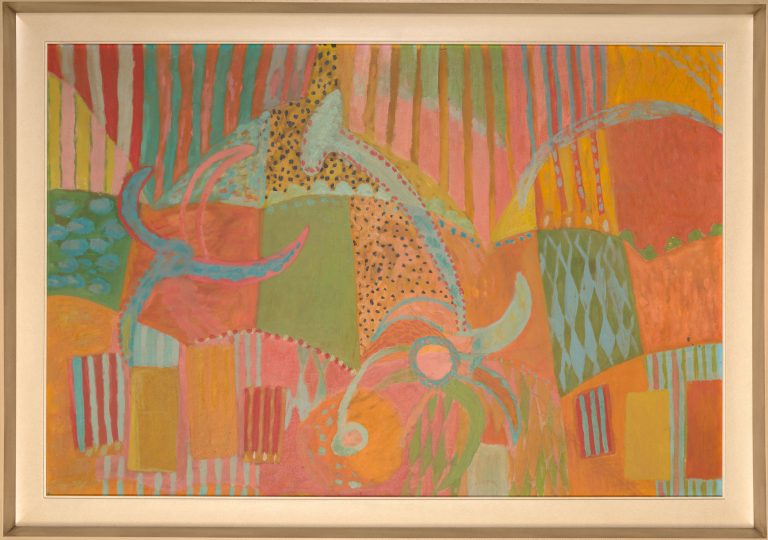We acknowledge the Traditional Owners of the land on which the Queensland Art Gallery | Gallery of Modern Art stands and recognise the creative contribution First Australians make to the art and culture of this country.

Jon Molvig / Australia 1923–70 / (Carnival motif) c.1952 / Oil on board / 67.1 x 100.7cm / Purchased 2016 with funds from the Estate of Betty Quelhurst through the Queensland Art Gallery | Gallery of Modern Art Foundation / Collection: Queensland Art Gallery | Gallery of Modern Art / © Otte Bartzis
Jon Molvig(Carnival motif) c.1952
Not Currently on Display
Jon Molvig probably completed (Carnival motif) in early 1952 while travelling in Europe. In her 1984 monograph on Molvig, Betty Churcher suggested a number of artists, whose work Molvig saw firsthand in Europe, had directly influenced his approach to this painting.1
The most notable is Pierre Bonnard (1867–1947), seen in the choice of colours and the application of paint. The other is the work of the Norwegian expressionists, which Molvig viewed at the Nasjonalgalleriet, Oslo, in 1951, in particular the work of Edvard Munch (1863–1944). For Molvig, this visit confirmed the importance of expressive colour to carry the mood of a picture, and the use of strong, rhythmic patterning.
(Carnival motif) shows Molvig’s early desire to experiment with different styles, which would lead to the development of his own distinct visual language.
Endnotes:
1 Betty Churcher, Molvig: The Lost Antipodean, Allen Lane, Ringwood, Vic., 1984, p.29.
Jon Molvig was born in Newcastle, Australia, in 1923. After serving in New Guinea and the Philippines during World War Two, Molvig studied art for three years in Sydney, then went on to travel throughout Europe, where he encountered the German and Norwegian expressionists who would significantly influence his work.
From 1955 until his death in 1970, Molvig was based in Brisbane. A complex man, his career was characterised by radical shifts in style. Molvig was also known for his highly considered exploration of technique and the power of his symbolism.
It’s a matter of inventing symbols for what you want to say and putting the symbols down in paint . . . I believe that for every subject you tackle you must invent a new set of symbols and sometimes a new technique to say what you want to say.1 — Jon Molvig
Endnotes:
1 Jon Molvig Interviewed by Hazel de Berg in the Hazel de Berg Collection [sound recording], Hazel de Berg Collection, National Library of Australia, Canberra; DeB 15, June 1961, <http://nla.gov.au/nla.obj-214255022>, accessed July 2019.
Discussion Questions
1. What is the mood of (Carnival motif) c.1952?
2. Analyse the artist’s visual language. How has Molvig used colour, shape and line to communicate the atmosphere of a carnival?
Activities
Research a popular social or cultural event where people share in a collective human experience (for example, a sporting event, arts festival, music concert or makers’ market). Create an abstract artwork using relevant symbols, shapes and colours to convey the experience of the event. Develop a visual synopsis that explains your choice of media, colour and symbols.